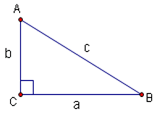Trigonometric identities
Trigonometric identities are used to manipulate tringonmetry equations in certain ways. Here is a list of them:
Contents
[hide]Basic Definitions
The six basic trigonometric functions can be defined using a right triangle:

The six trig functions are sine, cosine, tangent, cosecant, secant, and cotangent. They are abbreviated by using the first three letters of their name (except for cosecant which uses ![]() ). They are defined as follows:
). They are defined as follows:
Even-Odd Identities
Reciprocal Relations
From the last section, it is easy to see that the following hold:
Another useful identity that isn't a reciprocal relation is that ![]() .
.
Note that ![]() ; the former refers to the inverse trigonometric functions.
; the former refers to the inverse trigonometric functions.
Pythagorean Identities
Using the Pythagorean Theorem on our triangle above, we know that ![]() . If we divide by
. If we divide by ![]() we get
we get ![]() which is just
which is just ![]() . Dividing by
. Dividing by ![]() or
or ![]() instead produces two other similar identities. The Pythagorean Identities are listed below:
instead produces two other similar identities. The Pythagorean Identities are listed below:
(Note that the second two are easily derived by dividing the first by ![]() and
and ![]() )
)
Angle Addition/Subtraction Identities
Once we have formulas for angle addition, angle subtraction is rather easy to derive. For example, we just look at ![]() and we can derive the sine angle subtraction formula using the sine angle addition formula.
and we can derive the sine angle subtraction formula using the sine angle addition formula.
 ||
|| 
 ||
|| 
 ||
|| 
We can prove ![]() easily by using
easily by using ![]() and
and ![]() .
.
![]()
![]()
![]()
![]()
Double Angle Identities
Double angle identities are easily derived from the angle addition formulas by just letting ![]() . Doing so yields:
. Doing so yields:
$\begin{eqnarray*} \sin 2\alpha &=& 2\sin \alpha \cos \alpha\ \cos 2\alpha &=& \cos^2 \alpha - \sin^2 \alpha\ &=& 2\cos^2 \alpha - 1\ &=& 1-2\sin^2 \alpha\ \tan 2\alpha &=& \frac{2\tan \alpha}{1-\tan^2\alpha}$ (Error compiling LaTeX. Unknown error_msg)
Half Angle Identities
Using the double angle identities, we can now derive half angle identities. The double angle formula for cosine tells us ![]() . Solving for
. Solving for ![]() we get
we get ![]() where we look at the quadrant of
where we look at the quadrant of ![]() to decide if it's positive or negative. Likewise, we can use the fact that
to decide if it's positive or negative. Likewise, we can use the fact that ![]() to find a half angle identity for sine. Then, to find a half angle identity for tangent, we just use the fact that
to find a half angle identity for sine. Then, to find a half angle identity for tangent, we just use the fact that ![]() and plug in the half angle identities for sine and cosine.
and plug in the half angle identities for sine and cosine.
To summarize:
Prosthaphaeresis Identities
(Otherwise known as sum-to-product identities)
Law of Sines
- Main article: Law of Sines
The extended Law of Sines states
Law of Cosines
- Main article: Law of Cosines
The Law of Cosines states
Law of Tangents
- Main article: Law of Tangents
The Law of Tangents states









